Flat towing, 4 wheels down, is the preferred method of towing a vehicle for many RVers, and it’s not hard to see why. Compared with other options, it’s very fast to both connect and disconnect, and the equipment involved takes us very little space. But there is one major catch: you can’t flat tow most vehicles. In fact, the answer to what cars can be flat towed behind an RV may surprise you. Let’s take a look.
- 1) What Cars Can Be Flat Towed Behind an RV?
- 2) What Is Flat Towing (Or Dinghy Towing)?
- 3) Can Any Car Be Flat Towed Behind an RV?
- 4) Popular Cars for Flat-Towing Behind an RV
- 5) How to Know If a Vehicle Can Be Safely Flat Towed Behind an RV
- 6) Modifying a Vehicle To Flat Tow
- 7) Alternatives to Flat Towing
- 8) We LOVE Flat Towing Our Car!
What Cars Can Be Flat Towed Behind an RV?
Before we take a look at flat towing, it’s worth considering your towed vehicle’s purpose and what kind of cars, trucks, or sport-utility vehicles might meet your needs as a “toad” (the common slang for “towed car”).
For RVers who love to go off-road or have lots of stuff to tote around, like bikes or kayaks… or kids, it may make sense to bring along a larger vehicle. For others who just need a smaller car for quick trips around town or to explore the local area, sedans or even smaller models can provide what you need without adding too much length or weight to your setup.
What Is Flat Towing (Or Dinghy Towing)?
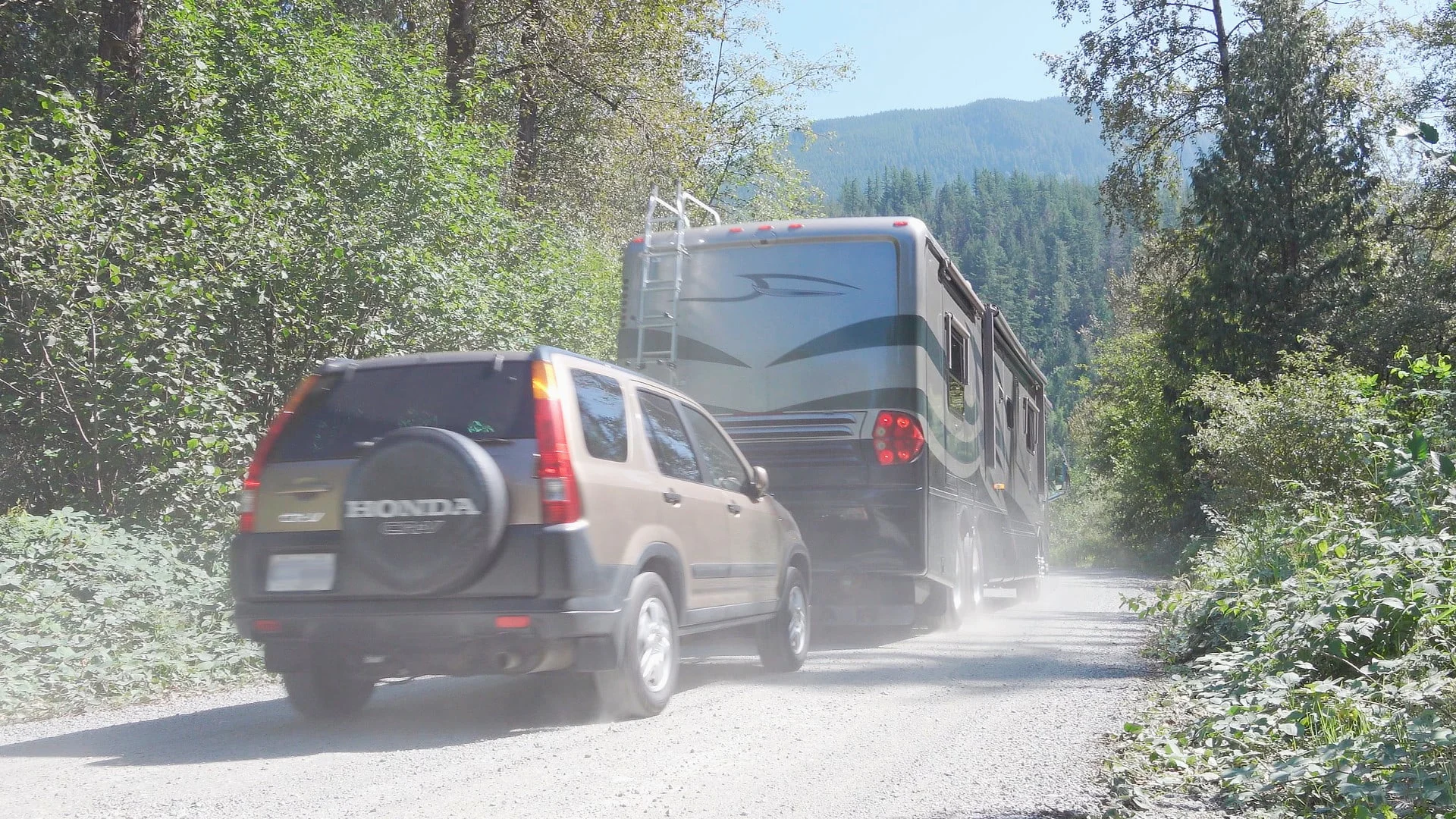
With flat towing, all four wheels of the vehicle being towed stay on the ground.
Flat towing, also known as “dinghy towing,” is a method of towing your vehicle behind your RV with all four wheels on the ground. The tow vehicle is attached to the RV via a tow bar and simply rolls along behind as you drive.
The main upsides to flat towing are:
- the ease and speed of connecting and disconnecting
- the small amount of space the system takes up (in most cases, almost none)!
Because you don’t need to get your car up onto a tow dolly or trailer, you save a lot of time and hassle. And because the components are far smaller than a dolly or trailer, you don’t need to worry about finding extra space at your campsite.
Can Any Car Be Flat Towed Behind an RV?
Definitely not! The main downside to flat towing is that you can’t do it with many common vehicles, thanks to issues involving some modern car transmissions. You can cause severe transmission damage if you try to flat-tow a car that isn’t designed for it.
Generally speaking, you can safely flat tow vehicles with rear-wheel drive and manual transmission, or cars with four-wheel drive and a manual transfer case. But even these rules don’t hold in every case. The best resource for identifying cars that are approved for flat towing is the annual Motorhome Magazine Dinghy Towing Guide, which covers vehicles manufactured over the past 30+ years.
View The Motorhome Magazine Dinghy Guides
Even after checking the dinghy towing guide, there’s no more important place to confirm that flat towing is allowed than an individual vehicle’s owner’s manual. If it says you can’t flat tow…. don’t. Or at least not without modifying it first. That’s right… some non-flat-towable cars can be modified to make them safe to tow. More about that a little further down in this article.
Popular Cars for Flat-Towing Behind an RV
Want to know what cars can be flat towed behind an RV? Start by checking out the ones you frequently see your fellow RVers using! A quick drive through an RV Park or campground may be all the research you need.
A few vehicle brands and models consistently get high marks for flat towing behind an RV. Jeep is among the most popular, with its Wrangler and Grand Cherokees frequently used as tow vehicles.
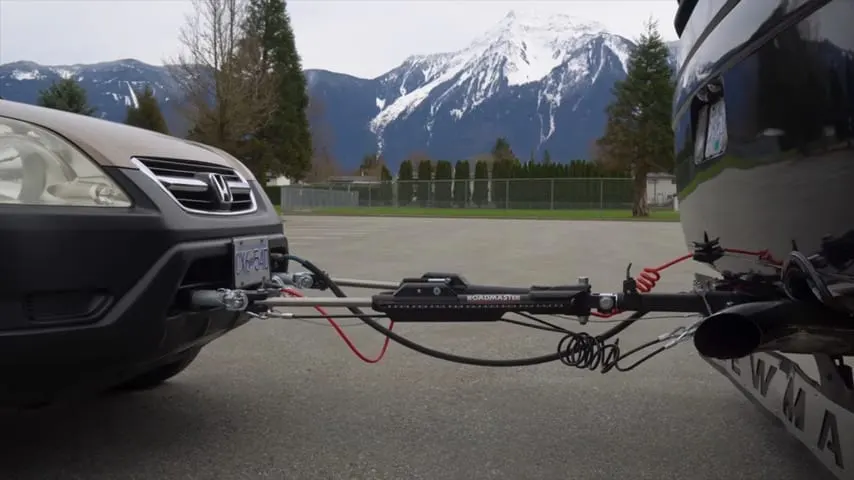
We bought our 2003 Honda CR-V brand new, specifically to tow behind our RV, and it’s been the perfect tow vehicle for us ever since. It’s a stick, but automatic transmission models were flat towable back then, too (only until 2014).
Those who need the power and space of an SUV or pickup truck might check out the Ford F-150, Chevy Colorado, or Dodge Durango. On the smaller end, the Ford Focus and Mini Cooper are popular. In between these two extremes, midsize SUVs like the Chevy Equinox, and GMC Terrain, or our very own Honda CR-V (model year 2014 and earlier only, due to the switch to variable CVT transmissions in 2015, and the elimination of a manual transmission option).
How to Know If a Vehicle Can Be Safely Flat Towed Behind an RV
If terms like “manual transfer case” and “transmission lubrication” make your head spin, consult your car’s owner’s manual (or contact the manufacturer directly if possible) to confirm whether you can flat tow your vehicle… before attempting it. Again, flat towing can cause severe damage if your car or truck doesn’t have flat tow capabilities, so it’s better to be safe than very sorry.
Also, many cars that are safe to flat tow still require that certain procedures be followed before, or during, towing. For example, it’s common for a vehicle manufacturer to limit flat towing to a certain speed, or a number of hours, after which the engine must be started, and the transmission shifted through the gears.
And some toads can require A LOT of steps to prepare for towing each time. Our 2003 manual-transmission CR-V has NO steps or limits on towing, something that really appealed to us, along with its versatility and reliability.
Modifying a Vehicle To Flat Tow
The biggest reason that some vehicles can’t be flat-towed behind a motorhome is that their transmission is only lubricated when its engine is running. Without that lubrication, the transmission could overheat and may even burn up while dinghy towing. To address that, there are companies that offer aftermarket lubrication pumps to circulate fluid through the transmission.
In other cases, you can modify the car you want to flat-tow by adding a driveshaft disconnect kit. With that installed (and the driveshaft disconnected), the transmission components aren’t moving during the towing process. Typically, driveshaft disconnect kits include a cable-operated control that’s installed under the dashboard of the towed vehicle, allowing you to easily disconnect the driveshaft before towing the car/truck. There are a number of vendors that offer kits like this.
Important Word Of Caution: Even though there are baseplates, transmission lubrication pumps, and other products available for newer vehicles, it doesn’t guarantee that they are flat-towable as far as the manufacturer is concerned. If the vehicle is not officially approved by the manufacturer for dinghy towing, the warranty will likely be void if a component failure occurs as a result of towing. Make sure you’re aware of all factors, and possible ramifications, of deciding to modify a vehicle to make it flat towable.
For more information about modifying a car/truck to flat-tow it behind your RV, check out Motorhome Magazine’s article on the topic.
Alternatives to Flat Towing
So, what do you do if you need a substitute tow option because you can’t flat tow a specific vehicle? There are two main alternative tow methods: using a tow dolly or a trailer.
- A tow dolly is sort of like half of a trailer. To use a dolly, you’ll drive your vehicle’s front wheels onto a small trailer, while the tow vehicle’s rear wheels roll on the road. In doing so, you can safely tow cars with front-wheel-drive transmissions.[br][br]Be aware — generally, dolly towing is strictly for front-wheel-drive vehicles. Most rear-wheel-drive or all-wheel-drive vehicles can’t be dolly-towed, unless they have a manual transmission, and are approved for towing with the rear wheels rolling (like being towed by a tow truck). Again, refer to the owner’s manual.[br][br]You’ll also have to find space to store your tow dolly while camping (but at least they require less space than trailers). The process of driving onto the dolly can also take a little practice at first.
- Trailering is the more expensive of these two options, but also the most versatile. You can take pretty much any vehicle you want as long as it fits on the trailer, and doesn’t exceed the towing and gross vehicle weight ratings for your RV.[br][br]When added to the RV and toad that you already have with you, a trailer can be too large for many campsites. So you may need to make arrangements for trailer storage with a campground.[br][br]An added advantage with one particular style of trailer (the enclosed type) is that your car won’t get dirty while being towed, no matter how bad the weather (although the trailer itself will need a good cleaning every now and then).
We LOVE Flat Towing Our Car!
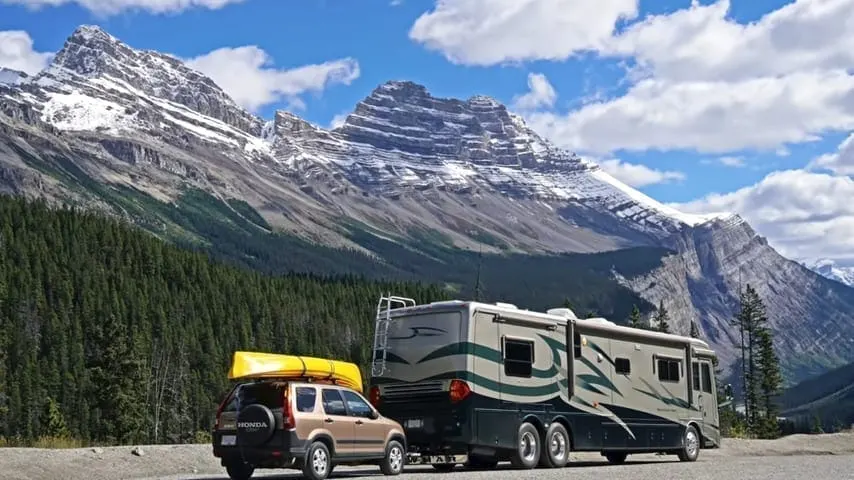
Our diesel-pusher easily flat-tows our Honda CR-V loaded with another little “toad” — our canoe.
Despite all the technical elements (tow bar, base plate, braking system, etc) and initial research to ensure that the vehicle you plan to flat-tow CAN be towed four-wheels-down, flat-towing is still a great option. It offers the fastest setup and disconnect time and doesn’t require you to have any additional space at your campsite to store a dolly or trailer.
Just be sure to check your prospective toad’s owner’s manual to confirm that it’s safe to do, and what steps are involved.
Even though neither of us had ever RVed before, we hit the road full-time in 2003. Despite a complete lack of experience, we made some great choices (like our Honda) and some that we improved upon after learning more. That includes our choice of tow bar. We upgraded to a Roadmaster Nighthawk, and are so happy with it that we were able to arrange a special package for you — a FREE tow bar cover and hitch receiver lock!
Call Roadmaster at (800) 669-9690 to order your Nighthawk tow bar factory direct and tell them you want “The RVgeeks Package”. You'll receive a FREE Tow Bar Cover & Hitch...Show More
Call Roadmaster at (800) 669-9690 to order your Nighthawk tow bar factory direct and tell them you want “The RVgeeks Package”. You'll receive a FREE Tow Bar Cover & Hitch Receiver Lock to keep your new Nighthawk secure and looking great. Free Shipping is also included!
The Roadmaster Nighthawk is our favorite RV tow bar. The non-binding latches ensure you'll have an easy time disconnecting, no matter how the RV and tow car are positioned. Longer arms make connecting and disconnecting easier. And the LED lights along the arms improve safety and visibility when towing!
Check out our latest Nighthawk video here
Show LessWhen you buy a made-in-the-USA Nighthawk directly from Roadmaster’s factory in Vancouver, WA, just tell them you want the “RVgeeks Package” and they’ll know to include the cover and lock in your order. After all, who wouldn’t want to protect their beautiful new tow bar?!
Happy towing!
Geek Out with Us Every Week
Join our newsletter to learn about all things RV-related. Every week we offer free tips, tricks, product reviews, and more to our online community of RVers. Whether this is your first time on the road or you’re a seasoned expert, we’d love for you to geek out with us!

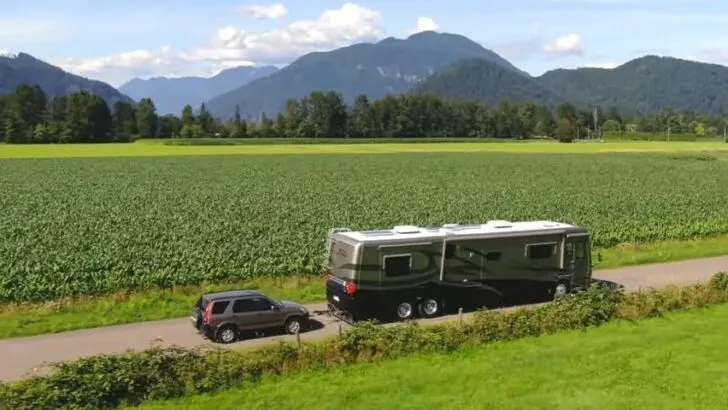
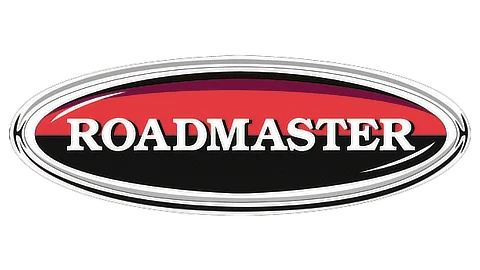
Gary McElroy
Friday 2nd of April 2021
I thought that it is worth mentioning that the RV cannot be backed up if the toad is flat or dolly towed but can be backed up if the toad is trailer towed. I still prefer flat towing, however. I have a 2009 Ford Escape Hybrid. Even though it has a CVT the owner's manual assures me that it can be flat towed.
Steve Lamb
Thursday 1st of April 2021
Thanks for the post. We also have a Honda CR-V, a 2002, which has an auto transmission. We use a BlueOx system and have been happy with it. Did you ever install some wiring to keep your Honda’s battery topped up while driving? We have had issues where the toad’s battery died and get an error on my Blue Ox control in the RV, thanks ~ Steve
TheRVgeeks
Thursday 1st of April 2021
Hey Steve. Things may be a little different between our manual-transmission CR-V and your automatic... we never had a battery problem towing ours. But we literally turn the key to unlock the steering wheel, then turn it back to "Off". So nothing is powered up to drain the battery AND the steering wheel stays unlocked. We do now have charging to the toad's battery when we're driving... it's powered by our Roadmaster Invisibrake braking system. That system pulls power from the parking lights when we have them on (they're powered by the RV through the umbilical) and uses it to keep the car's battery topped up. If you check the wiring diagram for your umbilical cord, there may be an unused one that you could leverage to bring 12V power from the RV over to the car while driving. Hope that helps!